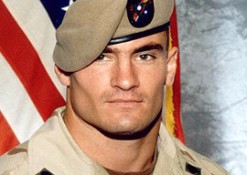
August 31, 2010

The Tillman Story is a documentary about Pat Tillman, the NFL player who, following 9/11, turned down a $3.6 million Arizona Cardinals offer to enlist as a private in the U.S. Army, then died in Afghanistan in 2004. The film has elicited critical praise but not much media hype.
Why not? As Afghanistan evolves into Mr. Obama’s War, antiwar sentiment is at a low ebb among the press.
In reality, The Tillman Story, directed by Amir Bar-Lev and narrated by Josh Brolin, is a lesser example of the documentarian’s art. Yet, it’s worth sitting through because of the light it shines on what’s becoming America’s forever war. It also affords us a glimpse of that mysterious hero who refused to do interviews about why he chose to fight for his country in an era when so few of the noblesse have been obliging.
The Tillman Story is most striking whenever Pat and his giant jaw are on screen. Like an American hero from the pre-Muhammad Ali era, Tillman wanted fame, but he wanted to earn it, and without boasting, without PR.
Following the Spanish-American war, Rudyard Kipling advised America to take up the burdens of empire. Yet, he didn”t understate the costs: “Send forth the best ye breed / Go bind your sons to exile / To serve your captives” need.” Tillman, a thoughtful, eccentric, idealistic badass, was the best we breed.
After getting in trouble with the law in high school for beating up a guy, Pat channeled into more productive directions his ferocious level of testosterone. (Tillman might be the only man to grow a beard to make his jawline look less rugged.) An academic All-American at Arizona St., he wasn”t expected to make it as a rare white defensive back in the NFL, but he did.
Afforded a gloriously outdoorsy Northern California boyhood by their vaguely Sixties-style parents, a lawyer and a teacher, the Tillman brothers decided to repay their country by continuing their soldier grandfathers” tradition of bearing arms, despite their deepening doubts about Iraq. Pat looked forward to meeting foreign policy critic Noam Chomsky after his discharge. It’s not wholly absurd to dream that in, say, 2025″unlike Professor Obama in 2009″a President Tillman would have been man enough, and patriot enough, to stare down the neocons and generals and denounce the invade-the-world mindset.
Although constructed around his bereaved (and then outraged) family’s search for the truth, The Tillman Story unfortunately gives away the main spoiler”he was shot by his own comrades in arms”before the halfway point.
As best I can piece together what happened, after hearing a detonation and subsequent shooting in the deep canyon engulfing his brother Kevin’s half of the Black Sheep platoon, Pat charged back to the rescue. An Afghan Army trainee spontaneously decided to follow the American alpha male. Sayed Farhad began firing wildly, just like the amped-up American Rangers in the lead Humvee below. Seeing muzzle flashes coming from a bearded local, the Rangers shot him, then turned their fire on his colleague, who turned out to be Tillman.
It wasn”t a fragging, and it wasn”t a Delta Force black ops assassination. It was just Situation Normal for combat. Stephen Hunter described in American Gunfight the impact of adrenaline overload: “You feel nothing, you see only a little bit of what’s ahead of you, you hear nothing … Meanwhile, your fingers inflate like sausages and your IQ drops stunningly.”
Viewers can infer much from The Tillman Story about the futility of what Kipling called “the savage wars of peace.” Since the Gulf War of 1991, a sizable fraction of American fatalities have been due to “friendly fire” because the American advantage in firepower is so overwhelming. (U.S. forces in Iraq and Afghanistan fired in anger an average of about a quarter of a million bullets per day.) And U.S. marksmanship is lethally good. (The Army coroner who autopsied Tillman’s bullet-riddled corpse refused to certify that he”d been killed by hostile fire because the Taliban can”t shoot that straight.)
If two or three insurgents can stampede elite Army Rangers into hosing down the most famous enlisted man since Elvis, how good can they realistically be at judiciously”yet instantaneously”deciding during a firefight whether a bearded, AK-47 toting local is friend or foe? In a Pashtun culture that cherishes vendetta, how can we therefore evade chronic feuds?
The Tillman Story then inquires into the Army’s feckless five-week cover-up of the fratricide. Why did everybody in the chain of command, from the grunts who didn”t tell Kevin Tillman that they had killed his brother to the Pentagon’s PowerPoint warriors, obfuscate? Having been involved in a number of organizations, I can attest that that’s what organizations do: try to dodge blame. The main difference in willingness to acknowledge errors I”ve noticed between the Army and the various marketing corporations I worked for is that marketing mistakes less often kill people and break things.